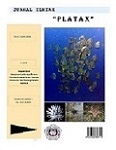Seasonal Variations of Temperature, Salinity and Turbidity of the Lembeh Strait’s waters, North Sulawesi
DOI:
https://doi.org/10.35800/jip.8.1.2020.28293Keywords:
temperature, salinity, turbidity, oceanography, Lembeh StraitAbstract
Research on seasonal variations of temperature, salinity and turbidity of the Lembeh Strait’s waters were carried out in March 2016 to February 2017. Observations of temperature, salinity and turbidity were conducted using the Sonde EXO-2 multi parameter tool. The purpose of this study was to determine the seasonal effect on temperature, salinity and turbidity Lembeh Strait’s water. The results of the statistical analysis using ANOVA and Tuckey's test showed that the season affected the salinity and temperature, whereas no significant effect were observed on turbidity. Variations in temperature, salinity and turbidity are affected by external factors such as weather, wind and seasonal current patterns occurred in these waters. The conditions of temperature, salinity and turbidity of sea water in Lembeh Strait are still adequate for marine life.
Keywords: temperature, salinity, turbidity, oceanography, Lembeh Strait
References
Banjarnahor, J., 2000. Atlas Ekosistem Pesisir Tanah Grogot, Kalimantan Timur. Puslitbang Oseanologi – LIPI Jakarta, hal. 17.
Birowo, S. & Ilahude A. G. 1987. Oceanographic features of the Indonesian waters. Center for Oceanological Research and Development-LIPI.Jakarta
Effendi, H. 2003. Telaah kualitas air bagi pengelolaan sumberdaya dan lingkungan perairan. Cetakan kelima. Yogjakarta: Kanisius.
Eliza, 1992. Dampak Pariwisata terhadap pertumbuhan terumbu karang. Lingkungan dan Pembangunan. Vol. 12(3): 150-170.
Hadikusumah dan Sugiarto, 2001. Penelitian Sumberdaya Laut di Kawasan Pengelola dan Pengembangan Laut (KAPPEL) Sulawesi Utara. Bidang Oseanografi, Proyek Pengembangan dan Penerapan IPTEK Kelautan. Laporan Akhir. Pusat Penelitian dan Pengembangan Oseanologi. Lembaga llmu Pengetahuan Indonesia: 1-21.
Ismail, M.F.A. dan Taofiqurohman, S.A., 2012. Sebaran Horizontal Suhu, Salinitas dan Kekeruhan di Pantai Dumoga, Sulawesi Utara. Jurnal Harpodon Borneo Vol. 5(1): 51-56.
Ippen, A.T., 1966. Estuary and Coastline Hydrodynamics. Mc. Graw-Hill Book Company, Inc.: 744 pp.
Menteri Negara LH, 2004. Keputusan Menteri Negara Lingkungan Hidup No.51 Tahun 2004 Tentang Baku Mutu Air Laut Untuk Biota Laut. Jakarta, hal. 32.
Noaa, 1994. Report to the Nation and Climate Prediction: 37-42.
Nontji, A., 2002. Laut Nusantara. Penerbit Djambatan. Jakarta: 59-67.
Nybakken, W.J., 1988. Biologi Laut. Suatu Pendekatan Ekologis. Gramedia, Jakarta: 459 hal.
Officer, C.B., 1976. Physical Oceanography of Estuaries and Associated Coastal Waters.John Willey and Sons. New York: 465 pp.
Pond and Pickard, 1978. Introductory Dynamical Oceanography. Pergamon Press. Pub. Headington Hill Hall, Oxford: 486 pp.
Romimohtarto, K dan Thayib, S.S., 1982. Kondisi Lingkungan dan Laut di Indonesia, LON-LIPI, Jakarta: 246 hal.
Triyulianti, I,. Radiarta, I.N., Yunanto, A., Pradisty, N.A., Islami, F. dan Putri, M.R., 2018. Sistem Karbon Laut di Perairan Laut Maluku dan Laut Sulawesi. Journal of Fisheries and Marine Research Vol. 2(3): 192-207.
Wilson, P.C., 2010. Water Quality Notes: Water Clarity (Turbidity, Suspended Solids, and Color). Department of Soil and Water Science. The University of Florida.
Wyrtki, K., 1961. Physical Oceanography of the South East Asian Waters. Naga Report, Vol. 2: 196 pp.
Downloads
Published
How to Cite
Issue
Section
License
COPYRIGHT
Authors who publish with this journal agree to the following terms:
Authors hold their copyright and grant this journal the privilege of first publication, with the work simultaneously licensed under a Creative Commons Attribution License that permits others to impart the work with an acknowledgment of the work's origin and initial publication by this journal.
Authors can enter into separate or additional contractual arrangements for the non-exclusive distribution of the journal's published version of the work (for example, post it to an institutional repository or publish it in a book), with an acknowledgment of its underlying publication in this journal.
Authors are permitted and encouraged to post their work online (for example, in institutional repositories or on their website) as it can lead to productive exchanges, as well as earlier and greater citation of the published work (See The Effect of Open Access).






































